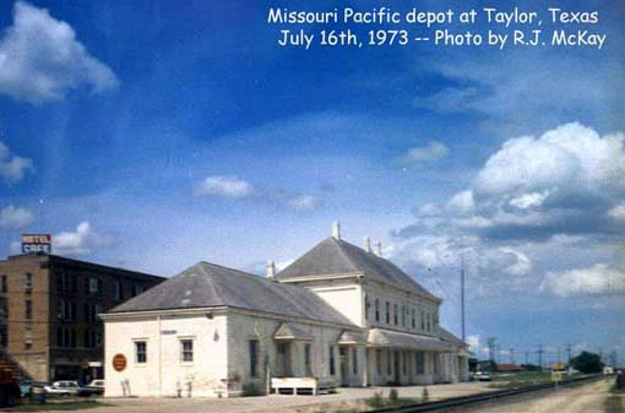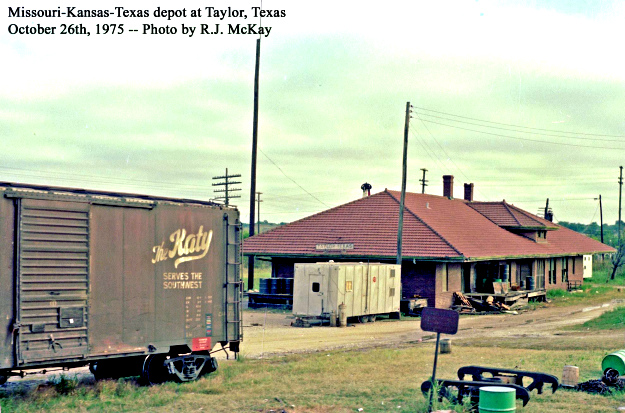Texas Railroad History - Tower 34 - Taylor
A Crossing of the Missouri, Kansas & Texas
Railway and the International & Great Northern Railroad
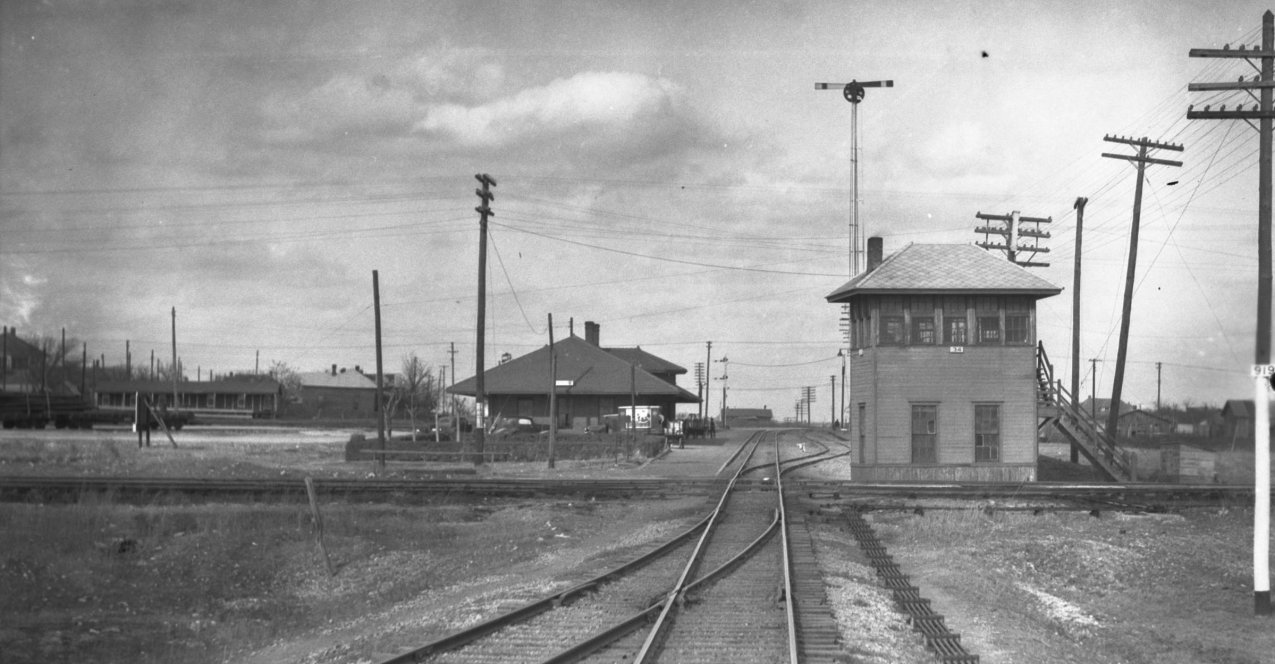
Above: Railroad
executive John W. Barriger III snapped this photo of Tower 34 from the rear
platform of his business car sometime in the 1930s. Barriger was facing north as
his train headed south on tracks of the Missouri - Kansas - Texas ("Katy")
Railroad. Moments before, Barriger's car had crossed over the diamond at the
Katy's intersection with the International - Great Northern (I-GN) Railroad that
went east / west through Taylor. The Katy's passenger depot is visible to the
left of the tracks. From this angle, the front dormer aligns with the depot's
far wall to present the illusion of another building beyond the depot. The Katy freight
depot is just off the left edge of the image, reached by a spur, with an
exchange track behind it.
Below:
On a different trip eastbound on the I-GN, Barriger took this photo looking
west toward downtown Taylor with the tower sitting in the northeast quadrant of the diamond.
To the immediate right of the tower, the large, light-colored I-GN passenger
depot looms in the background, vaguely discernable behind numerous signal and
utility poles. The south end of the Katy passenger depot is visible trackside to
the right, and the
Katy freight depot sits to the left behind it, partially obscuring a cooling tower and
smokestack of the
Southland Ice Company (long before it morphed into the convenience store
giant of 7-Eleven fame.) (photos courtesy John
W Barriger III National Railroad Library)
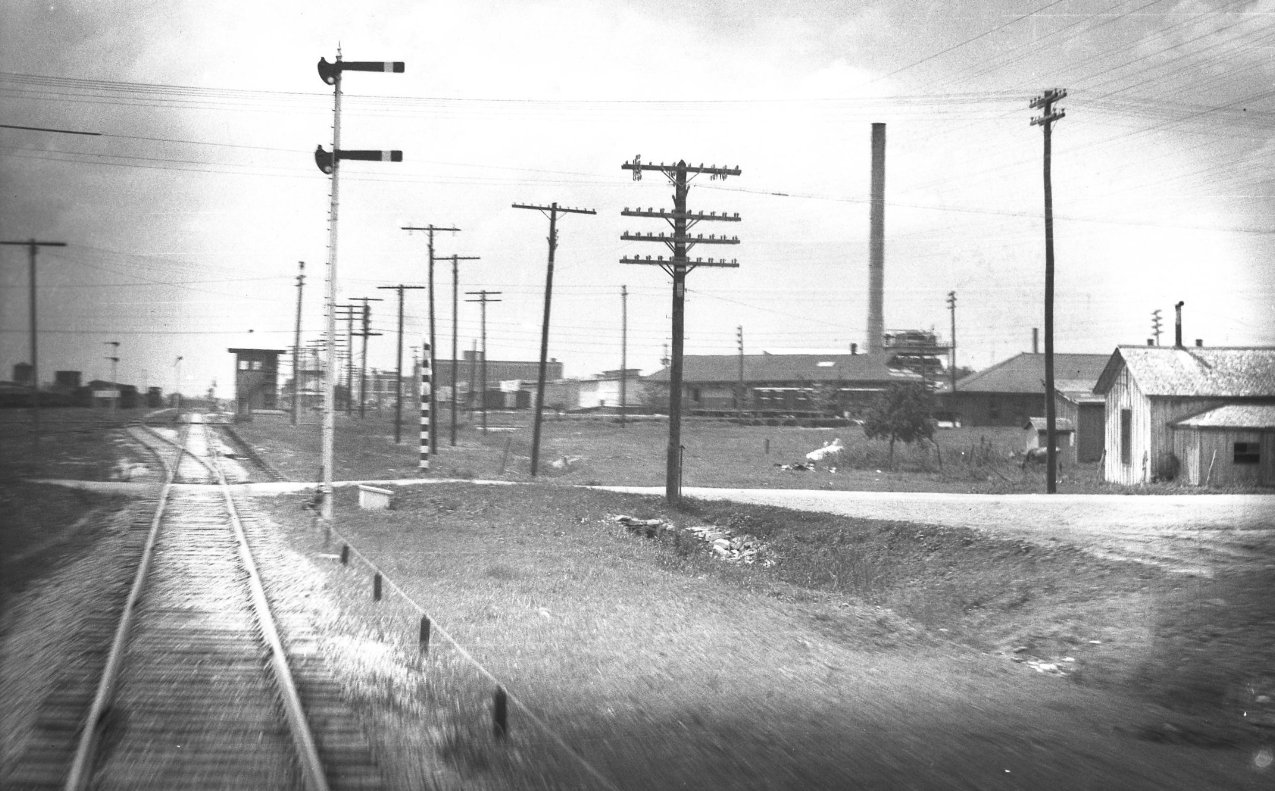
The International & Great Northern (I&GN) Railroad was the
combination of two unaffiliated companies, the International Railroad and
the Houston & Great Northern (H&GN) Railroad. The earliest to be
chartered was the
H&GN founded in 1866 by Houston interests with a plan to build
north to the Red River. Construction was delayed for several years;
major New York banks were reluctant to lend money to Texas
railroads during the initial Reconstruction period after the Civil War.
Work finally began in Houston in December, 1870. In May, 1873 when the H&GN's
track gang reached Palestine 151 miles north of
Houston, it
marked the third construction team to enter the town in less than a year!
The
other two had been crews of the International Railroad arriving into Palestine from
opposite directions. The International had been chartered in 1870 to build a line from Texarkana
to the southern border at Laredo
via Austin and San Antonio. It would essentially be an extension of the
St. Louis, Iron Mountain & Southern (SLIM&S) Railway which was building from St. Louis to Texarkana.
The International's construction had commenced in 1871 at two locations, northeast
from Hearne
and southwest from Longview. Friendly tracks of the Texas & Pacific
(T&P) Railway would fill the gap between Longview and
Texarkana.
Before the H&GN had reached Palestine, the management of the
International had recognized the value in a combined railroad that would add
Houston -- with favorable connections to Galveston
-- to the International's destinations. An agreement was reached to merge the
two companies to become the International and Great Northern Railroad (I&GN)
Railroad. In December, 1872, the railroads began operating under a combined
management structure led by Herbert Melville "Hub" Hoxie as General
Superintendent of both railroads. The International's offices were moved from
Hearne to Houston so that Hoxie could run both railroads while awaiting
permission from the Legislature to merge. Having completed its line from
Longview to Hearne, the International resumed construction toward
Austin. A sale of town lots at Rockdale was held on
September 3, 1873, several months before the rails reached there on
January 28, 1874. Construction was halted at Rockdale for more
than two years as politicians and journalists debated the issue of railroad
subsidies which had suddenly engulfed the International and its management.
The
International had submitted a claim for construction
bonds to be issued by the State in accordance with the
railroad's charter. Claiming corruption, the Texas
Comptroller refused to countersign and register the bonds despite
the State Engineer reporting that the work covered by the bonds was of
high quality and met the requirements of the railroad's charter. As
legal proceedings moved slowly, a lengthy debate raged
statewide for more than two years. Much ink was spilled as
to whether the bond issuance was in accordance with state law, or
instead constituted a demand by the International for an
unconstitutional subsidy. Legislators are usually responsive to
their constituents, and those constituents wanted railroads
now. This was certainly true in Austin,
which only had one rail line (to Houston), and it was definitely true in San
Antonio, which had no railroads at all. A compromise was ultimately found, and
the I&GN charter was granted by state law in 1875. By then, the
I&GN name had been appearing in newspapers for a couple of years, even though it
legally remained two separate railroads. It was not uncommon to see all three
names -- the International, the H&GN and the I&GN -- mentioned in a
newspaper on
the same day.
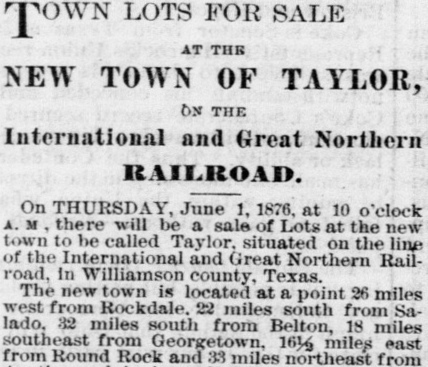
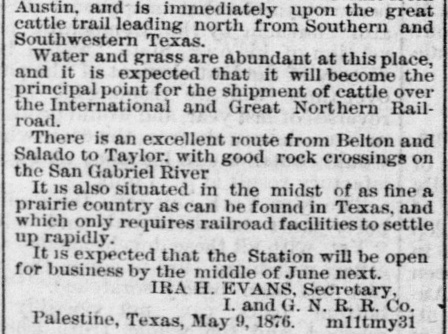
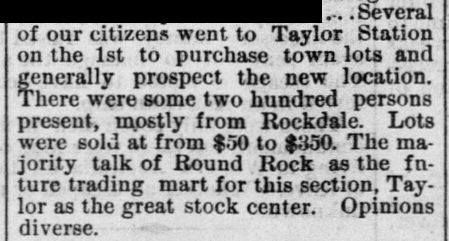
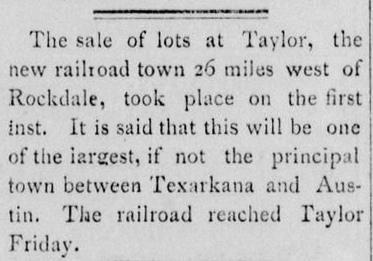
Above:
Construction finally resumed out of Rockdale on May 22, 1876, and the I&GN rails
reached Taylor in late June. Anticipating its arrival, the sale of town lots at
Taylor was scheduled for June 1 and was announced in the
Galveston Daily News of May 16, 1876. The
results of the sale were reported beneath a "Williamson County" subhead in the
"State News" column of the Galveston Daily News
of June 8, 1876. Note that this single paragraph (third from left) uses two different names for
the town: Taylor Station and Taylor. This would become a common theme. The Denison Daily News of June
24, 1876 noted that the "railroad reached Taylor Friday", which was the
prior day, June 23.
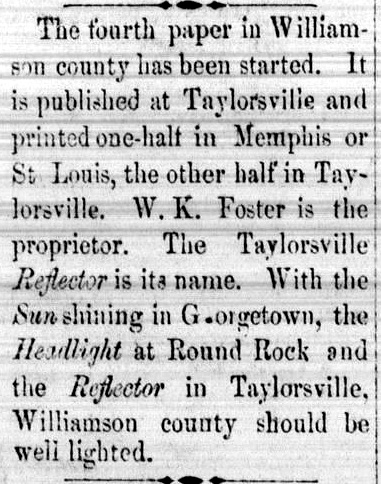 |
The town of Taylor was named for
Moses Taylor, a New
York banker and one of the wealthiest men in the U.S. He was a major investor in
both the H&GN and the International, and through them became the leader of a
financial syndicate backing the I&GN. Both Taylor and
Taylor Station were names initially used for the town, but
Taylorsville was ultimately adopted. Texas' largest newspaper, the Galveston
Daily News, began using Taylorsville
in March, 1877, yet Taylor continued to be referenced frequently in
newspapers across the state. Whether this widespread usage contributed
to the decision to shorten the town's
official name to Taylor is undetermined. The change reportedly
occurred in 1892, but postal
records pertaining to the revision have not been found in the
National Archives.
Left: A column editor
of the
Brenham Daily Banner of July 7,
1877 cleverly noted that the recent establishment of the Taylorsville Reflector
newspaper would help to ensure that "Williamson county should be
well lighted."
Six
months after the tracks had entered Taylor, they reached Austin on December 16,
1876. The I&GN did not
continue onward to San Antonio because the construction from Hearne to Austin
coupled with the lengthy delay at Rockdale had stretched the company's finances
to the breaking point. It badly needed operating revenue with which to
pay expenses and bond interest. On April 1, 1878, the company was forced
into receivership. After a year and a half in bankruptcy, it was sold at
foreclosure on November 1, 1879 to buyers who formed a new I&GN company
under the original charter and management team. The I&GN restarted
construction south from Austin in June, 1880. Routing
via San Marcos and
New Braunfels, the tracks reached San Antonio on February 16, 1881,
and were extended to Laredo later that year. |
The 1872 announcement of the plan to create the I&GN
had immediately caught the attention of notorious rail magnate Jay Gould. Gould
viewed the merger with alarm as the I&GN would have operations from Longview
through east and central Texas to the Gulf
coast and Mexico. Gould controlled Midwest
railroads, but to maximize their potential, he needed his own outlet to Mexico and
ports on the Gulf. The I&GN would be a large and powerful competitor, so Gould
began to develop a long term plan to take it over. Gould decided that the Missouri, Kansas & Texas (MK&T,
"Katy") Railroad could be a potentially valuable property to support
his quest. The Katy had bridged the Red
River into Texas in late 1872 and helped establish the town of
Denison, named for a Katy executive. The Houston &
Texas Central (H&TC) Railway had reached Denison in March, 1872, providing a
connection to Houston and Galveston for Midwest
passengers and freight. In a story of corporate intrigue worthy of a movie
script, Gould successfully
infiltrated Katy management with his loyalists over a period of several years
during the remainder of the 1870s. In late 1879 through the efforts of his
henchmen, Gould was elected President of the Katy though he had negligible
ownership of Katy stock.
Within a year, Gould had leased the Katy to the Missouri Pacific (MP) Railroad, a
large Missouri-based enterprise that he controlled and in which he had a large
ownership position. MP extended the Katy's tracks south from the Red River
bridge to
Fort Worth (1880) and
Hillsboro
(1881), then farther south to
Waco,
Temple and
Taylor in 1882. MP's route into Taylor came south along the east side of town,
placing its crossing of the I&GN southeast of downtown. To this day, the heart of
Taylor remains north and east of the diamond. All of this work was presented to
the public as MP activity; the Katy became invisible though it held title to the
tracks MP was building.
Right:
Dallas Daily Herald, February
2, 1882, one of the few newspaper reports to associate the track
construction with the Katy |
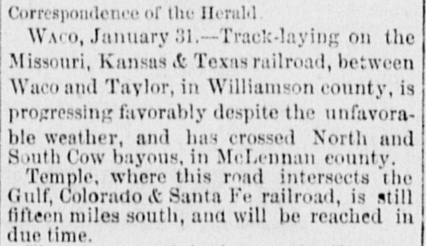 |
By the time the I&GN reached San Antonio, Gould
had already begun negotiations to buy a controlling interest. He had
successfully "hemmed in" the I&GN by acquiring control of both of the
aforementioned railroads -- the T&P and the SMIL&S -- that combined to provide
the I&GN's only direct connection to St. Louis from
Longview. On June 1, 1881, it was announced that Gould had acquired all of the
I&GN common stock in a two-for-one swap for Katy stock. Gould became President
of the I&GN and leased it to the Katy for 99 years while allowing the I&GN to
continue using its own name.
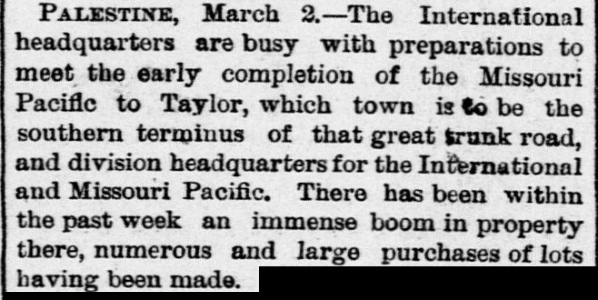 |
Left:
Since the Katy was leased to MP, the I&GN being under lease to
the Katy made it a major component of MP's routes in Texas. A shared division headquarters for both railroads was planned for Taylor. (Galveston Daily News,
March 3, 1882)
Right:
MP reached
Taylor on May 1, 1882 and connected with the I&GN. (Waco
Daily Examiner, May 3, 1882)
Note that neither article
uses the correct name of the town (Taylorsville) nor the correct name of
the owing railroad (Missouri, Kansas & Texas, "Katy"). |
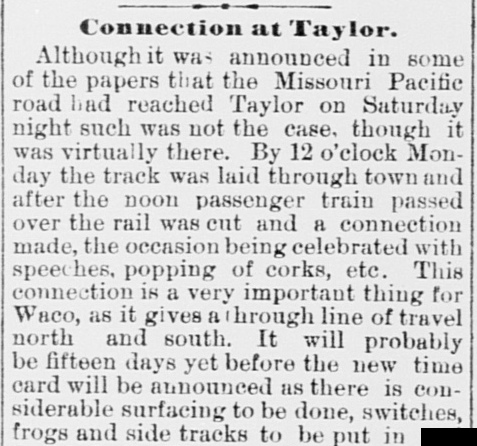 |
Neither the Katy nor MP was
headquartered
in Texas and neither had a Texas charter, yet Gould was somehow extending the Katy's tracks
southward, albeit with MP getting the publicity. An 1870 Texas law had allowed the Katy to enter Texas across
its planned Red River bridge under its Kansas charter to facilitate connection at Denison with the H&TC. But the Kansas charter had called for
construction south through Waco and Austin to reach the Rio Grande River, so
Gould was capitalizing on this loophole. Ostensibly he was merely following the
charter (not that he considered himself bound by it), but more significantly, he
recognized that Texas politicians always wanted more railroad service. It was
hard for Legislators to question the legality of MP's southward expansion while they
were making
speeches to their constituents at each town's celebration of new MP service.
For several years, the southern terminus of the MP / Katy tracks
remained at Taylor. This was mostly due to the political climate in the Texas
Legislature which in 1882 had repealed the land grant law and lowered authorized
passenger fares while pondering additional railroad regulation. Gould was wary
of additional investment at the time, but he still wanted to extend the Katy
tracks from Taylor to Houston. The urgency, however, was reduced now that he
owned the I&GN which served Houston. Five months after MP
reached Taylor, Gould bought the Galveston, Houston & Henderson (GH&H) Railroad
which at the time owned the only tracks between Houston and Galveston. Gould
assigned its ownership to the Katy which then leased it to the I&GN.
In 1886,
Gould directed MP to
resume construction out of Taylor heading for Houston
via Smithville. At the end of 1887, construction stopped eleven miles east of La
Grange at a location that MP called Boggy Tank. There was no progress
for several years as the Gould railroads entered a period of financial turmoil,
primarily related to the bankruptcy of the Wabash, St. Louis & Pacific Railway
which Gould had acquired in the early 1880s. The problems spilled over to MP
because Gould had leased the Wabash to the SLIM&S, part of the MP family.
Gould's
more immediate problem, however, was the election of James S. "Jim" Hogg in November,
1886 as Texas Attorney General. The focus of Hogg's campaign had been his claim
that Texas railroads were guilty of poor service, poor facilities, price-fixing
and other violations of their charters and other state laws. Hogg
began filing lawsuits against various railroads including the I&GN and the Katy.
Gould had allowed the I&GN to deteriorate, leading to poor service and
routine accidents, and he got away with it because most travelers
had no other choice. Railroad charters
required companies to maintain good facilities and good service, so Hogg
wasted no time going after the I&GN.
Right:
Galveston Evening Tribune, May 10,
1888
In addition to Hogg, Katy stockholders were after Gould
but they were having difficulty summoning a quorum for an official
meeting. Gould tried to prevent a meeting by resorting to judicial
intervention, but the stockholders prevailed in May,
1888. They fired Gould for malfeasance associated with the terms of MP's
lease, and then
promptly sought bankruptcy protection and a declaration that MP's lease
was void. Eventually, the Texas Supreme Court terminated MP's lease of
the Katy while also declaring the Katy to be a "foreign" railroad
because it lacked a Texas charter and headquarters. |
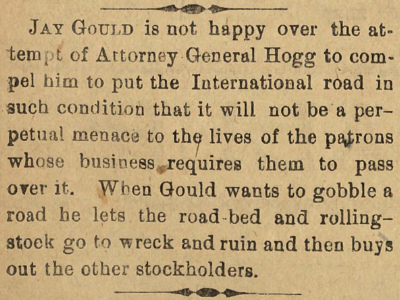 |
The
Katy would continue to operate in Texas under a Receiver until it could be
reorganized pursuant to a new Texas charter to be enacted by the Legislature.
Ironically, Gould remained President of the I&GN, ostensibly owned by the Katy.
Gould fought to ensure that the Katy could not retain the I&GN by pointing out to Hogg that the Katy's ownership of
the I&GN was illegal since the Katy was a "foreign" railroad.
Up to that point, the precise ownership of the I&GN had been finessed by Gould,
but he admitted it to Hogg to try to keep the Katy from owning the I&GN going
forward. The
Legislature passed a new Katy charter
law on October 28, 1891 granting rights to a newly created Texas subsidiary of
the parent Katy corporation. The subsidiary would be headquartered in Denison
and would own most of the Katy's current Texas rail lines, but not the I&GN.
Gould's delaying tactics had provided time for the Legislature
to sour on the idea of allowing
the Katy to own Texas' largest railroad. The Katy had little choice but to
sell the I&GN back to Gould.
The Katy's Texas charter was signed into
law by ... Governor Jim Hogg! He had been elected to that office in 1890 under a
campaign to establish a Railroad Commission of Texas (RCT). The end result was
that Gould had financial control of both the I&GN and the T&P but he had no
involvement with the Katy. Though MP was a Gould railroad, it was also a
"foreign" railroad and thus it no longer had any assets -- leased or owned --
in Texas. MP exchanged traffic with the T&P at Texarkana, and along with the
I&GN, the three railroads cooperated on passenger trains between St. Louis and
Houston. Unfortunately, Gould did not have much time to navigate this new
reality; he died in New York in December, 1892. His son George replaced Jay as
the President of both the T&P and the I&GN.
As for Jim Hogg ... he spent
much of his public life working to force the I&GN to improve its service and
safety record, but unfortunately, he learned the hard way that his efforts were
insufficient. In January, 1905, long after he had left office, Hogg suffered a
head injury when the I&GN train he was riding to Houston collided with a string
of freight cars. Though he believed his injury was minor, he ultimately needed
multiple surgeries over the next year to relieve brain swelling, and he
eventually succumbed to his injury in March, 1906.
Right:
In addition to the I&GN and Katy in Central Texas, three other large
railroads operated in the area.
Southern Pacific
The H&TC main line out of
Houston reached Denison in 1872, crossing the I&GN en route at Hearne. A
year earlier, the H&TC had completed a branch line into Austin off the
main line at Hempstead. By the end of 1883,
Southern Pacific (SP) had gained control of the H&TC.
Northwest
out of Austin, a narrow gauge line was built by the Austin & North
Western in 1882. It was reorganized as the Austin & Northwestern in 1888
and acquired by SP in 1891, which promptly converted it to standard
gauge. It crossed the I&GN at
McNeil and terminated at Llano, 82 rail
miles farther west.
East of Austin, the Katy's 1886 extension south from Taylor crossed SP's
tracks at Elgin.
In 1901-02, the I&GN would build a line (not shown) between Fort Worth and the
northern outskirts of Houston. It passed very close to Hearne, helping
to make the town one of the major rural rail junctions in Texas. Hearne
would become even more important when SP built the "Dalsa Cutoff"
(not shown) between Giddings and Hearne in 1914.
Santa Fe
The Gulf,
Colorado & Santa Fe (GC&SF) main line out of Galveston crossed the I&GN
at Milano and reached Temple in 1881.
Within a year, MP had crossed the GC&SF at Temple as it built Katy
tracks toward Taylor. In 1887, the GC&SF became part of the much larger
Atchison, Topeka & Santa Fe.
San
Antonio & Aransas Pass
The San Antonio & Aransas Pass
(SA&AP) had begun with construction of a line between San Antonio and
Corpus Christi in 1884. A lengthy branch
from Yoakum to Waco was completed in 1891.
It crossed the Katy at
West Point, the SP at Giddings, the I&GN at Rockdale, and the GC&SF at
Cameron. SP acquired the SA&AP in 1893,
lost control in 1903, and then reacquired it in 1925. |
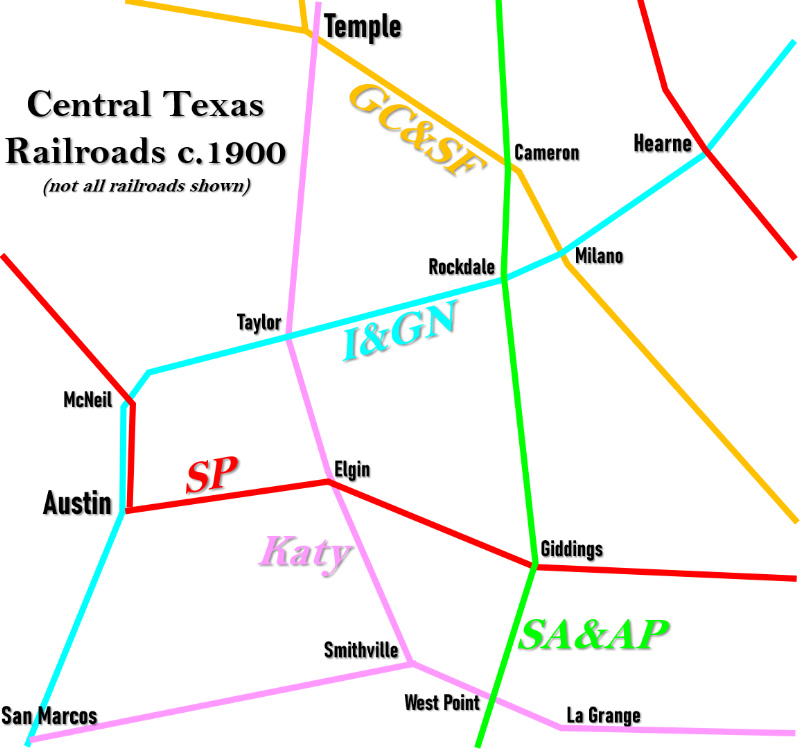 |
As a newly independent railroad on solid financial
footing, the Katy began a 25-year period of successful operations. It resumed
construction in 1892, building from Boggy Tank to the Brazos River, seven miles
east of Sealy. The remaining 42 miles from
the Brazos River to Houston was completed the following year. With tracks into
Houston, the Katy wanted to operate to Galveston, but the GH&H was still leased
to the I&GN which the Katy no longer owned. The Katy claimed in a Federal
lawsuit that it had a continuing right to operate over the GH&H. A settlement
was negotiated by George Gould in which the I&GN and the Katy each owned 50% of the GH&H
with unlimited rights to operate over it. In 1904, the Katy opened a branch
line to Austin. It departed the main line at Granger, eleven miles north of
Taylor, and went west to Georgetown and south to Austin via Round Rock. The Katy
negotiated trackage rights on the I&GN between Austin and San Marcos, enabling
it to connect with a branch line it had finished between Smithville and San
Marcos in 1892, a project Jay Gould had initiated. In 1901, the Katy built from
San Marcos to San Antonio, a requirement levied by the Legislature (ostensibly
to provide north / south route competition to the I&GN) in exchange for some
unrelated charter revisions the Katy had requested.
The Katy entered bankruptcy in 1915 and was operated
by a Receiver under court supervision until 1923. During that period, the
railroad came under the control of the U. S. Railroad Administration (USRA)
exercising powers granted by Congress in response to the Great War in
Europe. The post-war Transportation Act of 1920 terminated USRA's management of
the railroads and returned them to private ownership. It also granted
substantial control over the railroads to the Interstate Commerce Commission
(ICC). When the Katy's
receivership ended in 1923, it had a new name: the Missouri - Kansas - Texas Railroad
("M-K-T" or "MKT", but mostly just "the Katy".)
Purchased from the Katy
in 1892, the I&GN had remained
controlled by the Gould family but things did not go smoothly. It continued to
be notorious for accidents, particularly on its poorly constructed, poorly signaled main line between
Fort Worth and Houston that opened in
1902. It was under constant orders from RCT to correct various issues and
improve service with the acquisition of additional locomotives and passenger
cars. When the nation went into a depression caused by the
Panic of
1907, the I&GN was unable to make
bond payments and it went into voluntary receivership in February, 1908. To add
to the misery, the I&GN shops and roundhouse at Taylor were destroyed by fire
that same year.
 |
Left:
The Railway & Engineering Review,
September 26, 1908
Right: Southern Machinery,
February, 1910 |
 |
The
I&GN receivership lasted three years under the appointed Receiver, Judge Thomas Freeman, a former
T&P attorney. Freeman rehabilitated much of the I&GN's roadbed and its signaling systems
using $11 million in short term Receiver Certificates authorized for sale by the
Court. In June, 1911, the Gould family bought the I&GN out of bankruptcy and
named Judge Freeman to be the new President. Yet, revenues were insufficient to
retire the short term notes issued during the receivership, so the
I&GN went back into bankruptcy in 1914. At that point, the Gould family
connection to the I&GN ended forever. It was not until July 28, 1922 that the
I&GN emerged from bankruptcy as a newly reorganized company under the name
International - Great Northern Railroad, hence both I&GN
and I-GN
have been used as abbreviations for the railroad.
As for MP, the Gould family was no longer involved after a financial
reorganization in 1917. In 1924, MP tried to buy the newly independent I-GN as a
means of reentering the Texas market but the ICC refused to approve the sale. To
keep the I-GN away from other competitors, MP helped the New Orleans, Texas &
Mexico (NOT&M) Railway buy the I-GN. That sale was approved by the ICC in June, 1924
and six months later, MP was allowed to buy the
entire NOT&M on January 1, 1925. Thus it acquired the target I-GN plus the other assets
of the NOT&M, which operated in Texas and Louisiana under the moniker Gulf
Coast Lines.
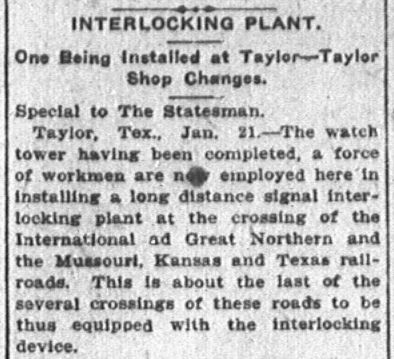 |
Pursuant to new a state law in 1901, RCT began
regulating the safety of crossings of two or more railroads. Their plan
was to have railroads deploy interlocker technology widely used
elsewhere, subject to RCT authorization and inspection. RCT commissioned
Tower 34 at Taylor on March 5, 1904 with a 28-function mechanical
interlocking plant built by Union Switch & Signal. This was more than
double the typical minimum plant size indicating that additional
signals and switches for connecting tracks were controlled through the
interlocker.
Left: The
Austin Statesman of January 22,
1904 carried this news item regarding the construction of the
interlocking tower at Taylor.
Right: Only a few months later on May 9, the
Austin Statesman reported that
heavy rains had damaged the tower. |
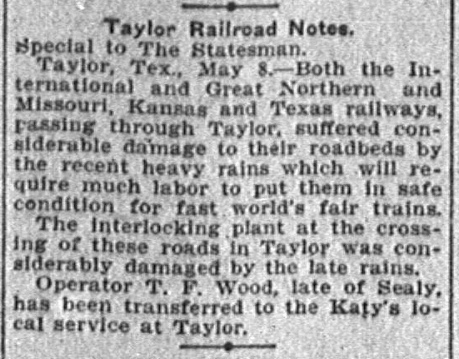 |
Since the I&GN / Katy crossing at Taylor existed prior
to 1901, RCT's rules specified that the capital expense for the
tower and interlocking plant would be shared equally by the railroads. The
recurring expense for tower operations and maintenance would be split
based on the ratio of interlocking functions assigned to each railroad compared
to the total function count. One railroad would take the lead for staffing and
maintaining the tower and it would bill the other railroad monthly for half of
the expenses incurred. In 1916, RCT reported that the Katy was currently
assigned the operations and maintenance responsibility for Tower 34. Whether the
Katy had been tasked with that effort at the initial commissioning of the tower is unknown. In most
cases, the railroad with staffing and maintenance responsibility was also the
railroad that had managed the design and construction of the tower.
However, the architecture of Tower 34 does not resemble the typical Katy tower
design, e.g. Tower 53, Tower 64,
Tower 93, all of which used concrete construction.
It is unlikely that the Katy altered its basic tower architecture after Tower 34
because Tower 53 -- a completely different design -- opened only four
months later. Tower 34's design could have been led by the I&GN, and if so,
perhaps the staffing responsibility had been transferred to the
Katy during the I&GN's bankruptcies in the 1907 - 1914 timeframe. Unfortunately, there are
insufficient photos of known I&GN towers to be able to ascertain any particular
architecture for comparison to Tower 34.
Historic aerial imagery shows
that Tower 34 was removed sometime between 1958 and 1963. The fate of the
structure is undetermined.
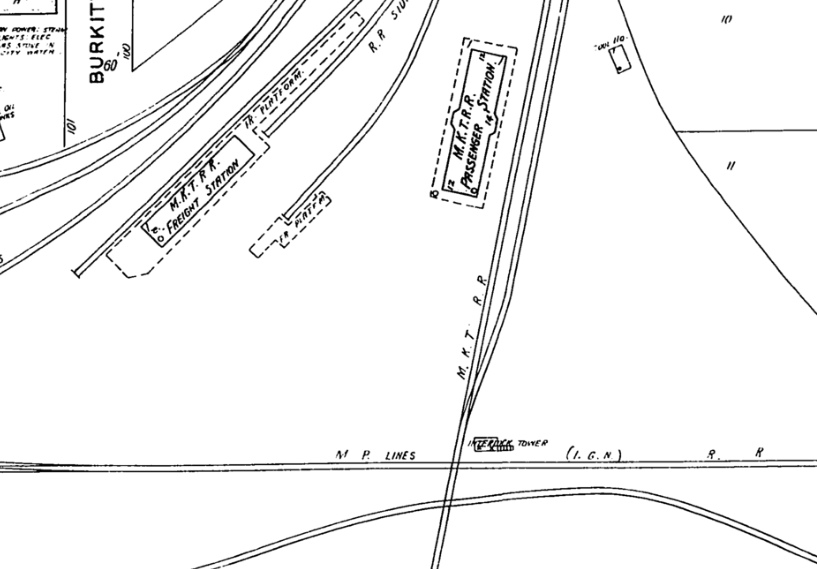 |
Left:
This image snippet from the 1931 Sanborn Fire Insurance map of Taylor
shows the tower located in the northeast quadrant of the diamond. The
track south of the I-GN main line is an industry spur that
connected to the I-GN off the map to the west. The Katy passenger station
was trackside a hundred yards north of the diamond while the I-GN passenger station was on the north side of the tracks about 500
yards west of the diamond (off the map.) RCT frequently issued orders requiring
railroads to build joint stations to support passenger connecting
traffic. No record of such an order for Taylor has been found nor has
any evidence surfaced of a "union station" at any earlier point in Taylor's
history.
Below: This magnification of the Sanborn Map shows that
the tower's staircase was on the east side of the building, consistent
with both photos at the top of the page.
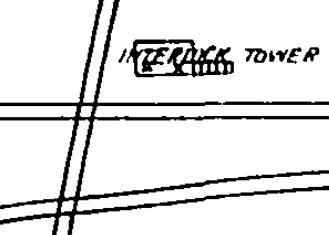 |
The I-GN continued to operate under its own name
within the MP family of railroads. In 1933, MP and all of its subsidiaries went
into a lengthy receivership largely caused by the Great Depression. The
receivership ended in 1956 when a new Missouri Pacific Railroad Company
was formed merging its separate railroads; they no longer carried
separate identities. The T&P, however, was not merged, even though MP
owned 75% of T&P's stock (an ownership position that dated back to 1930.) The T&P continued to operate independently but cooperatively with MP until
it was merged in 1976. MP was acquired by Union Pacific (UP) in 1982 but kept
its separate identity. The Katy remained independent until 1988 when it was acquired
by UP and merged into MP, one hundred years after MP's lease of the Katy had been
terminated by the Texas Supreme Court. Several years later, UP merged with SP
and the entire railroad now operates under the UP name.
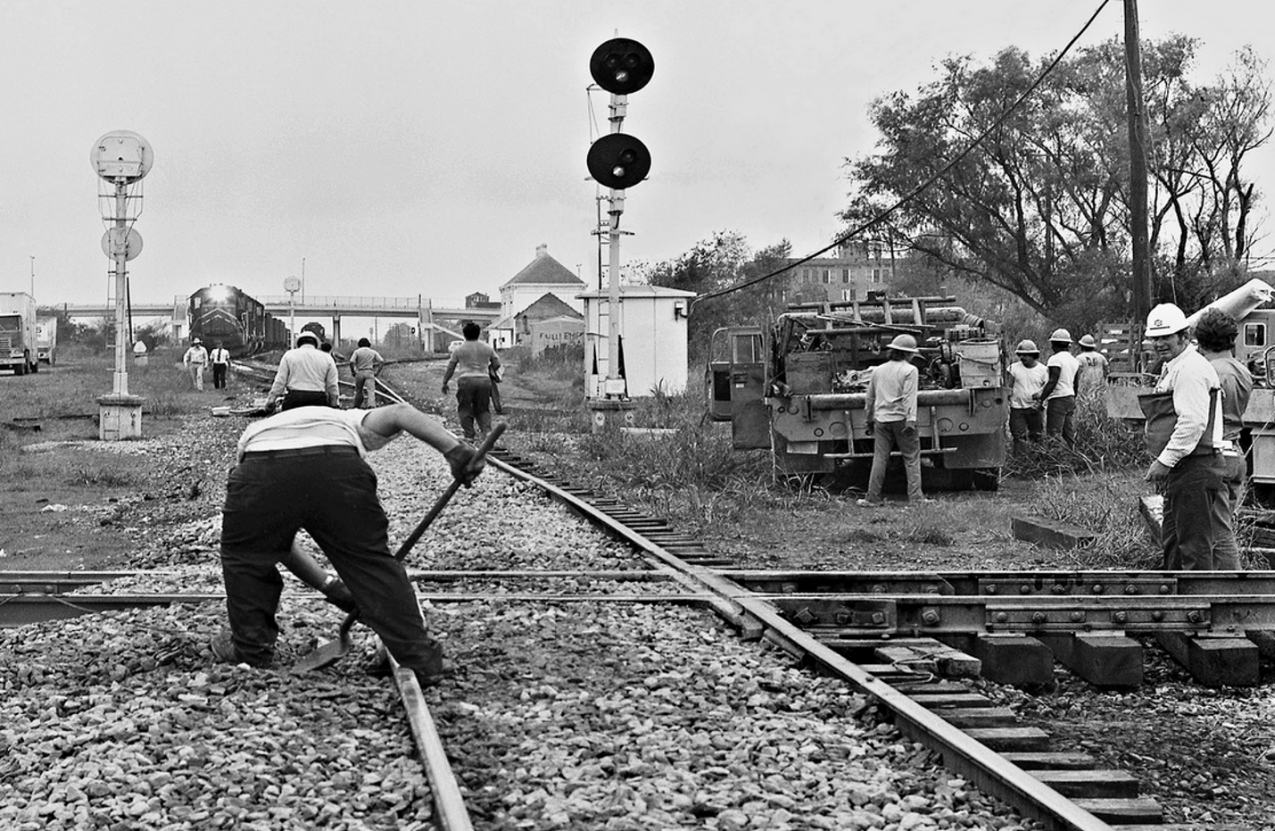
MKT / MP, Taylor, Texas, 1965
Track crew puts finishing touches on Missouri-Kansas-Texas Railroad crossing as
eastbound Missouri Pacific Railroad freight train waits in July, 1965.
Photograph by J. Parker Lamb (c) 2016 Center for Railroad Photography
and Art. Lamb-02-062-10
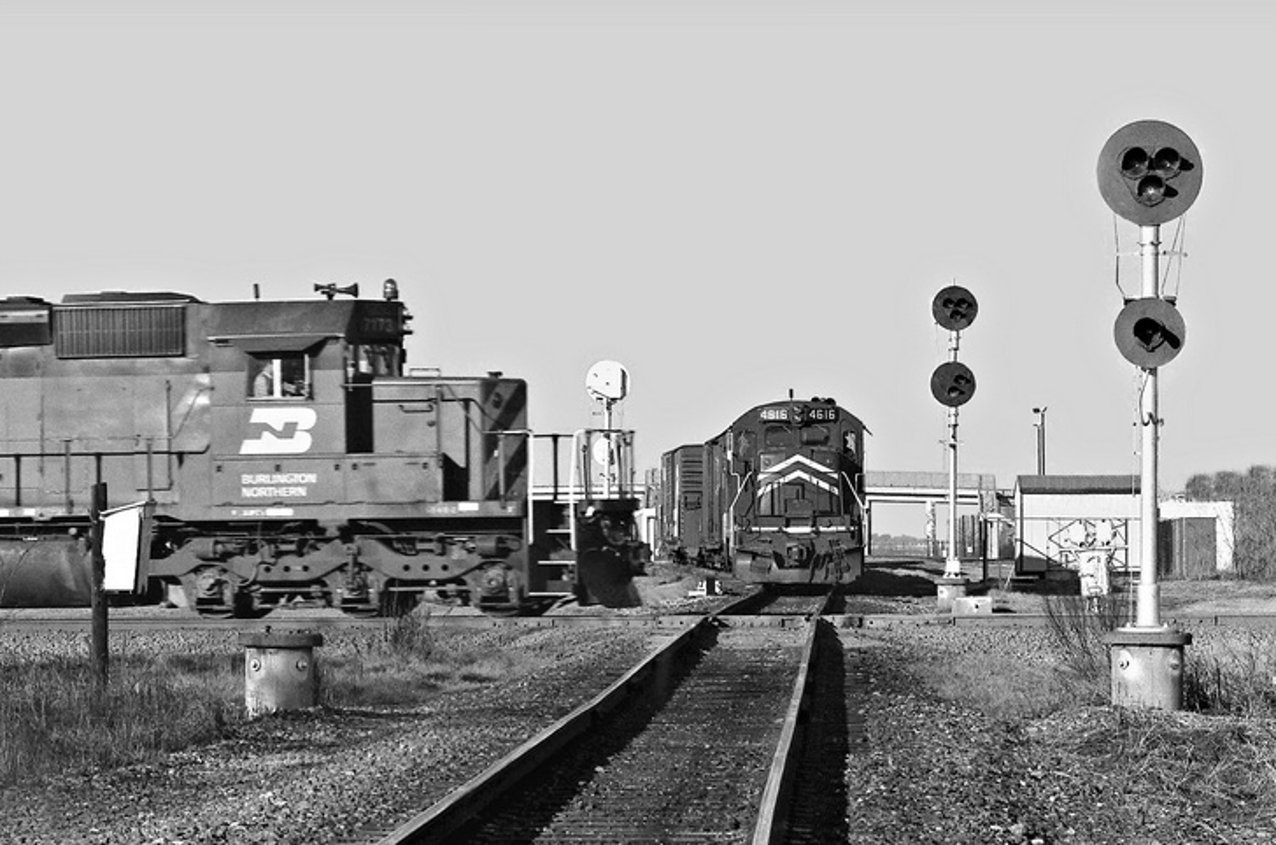
MKT/MP, Taylor, Texas, 1981
Northbound Missouri-Kansas-Texas Railroad empty coal
train with Burlington Northern power passes waiting eastbound Missouri Pacific
Railroad freight train at Taylor, Texas, in April, 1981. Photograph by J. Parker
Lamb, (c) 2016 Center for Railroad Photography
and Art. Lamb-02-046-09
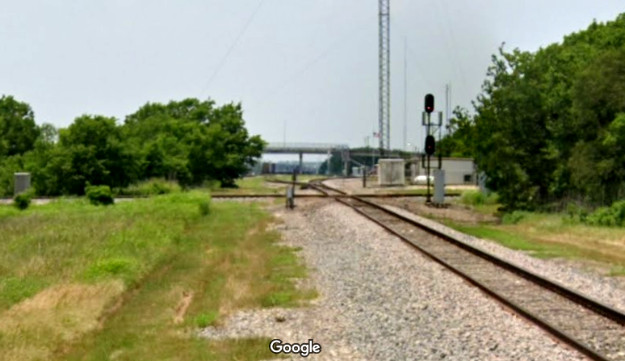
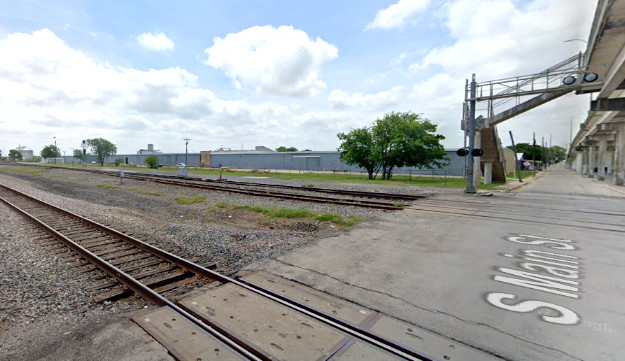
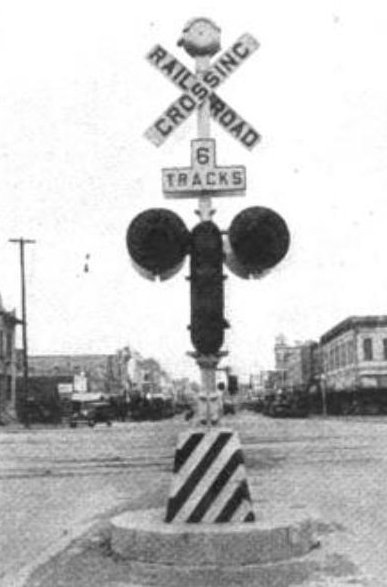
Above
Left: This Google Street View from 2022 faces west from the
Robinson St. grade crossing toward the former Katy / I&GN diamond, now a
crossing of two UP tracks. In the distance, the Main Street Overpass carrying
Texas Highway 95 is visible.
Above
Right: Google Street View captured this 2022 image of the Main
St. grade crossing of UP's former I-GN tracks. A grade separation project c.1965
built the overpass that carries the vast majority of the traffic. After
acquiring the I-GN, MP had expanded this crossing to a total of six tracks by
1933. A watchman's tower was used to raise and lower gates manually, but gate
crashes and other problems persisted.
Left: (Railway
Signaling, April, 1935) On December 13, 1933, MP activated a new
warning system for the Main Street grade crossing that used bells and red lights to warn drivers of approaching trains. The system did not
employ gates, but the
watchman's tower remained in use so the signals could be overridden when being
triggered by nearby switching movements that would not pass over the grade
crossing (otherwise, due to the proximity of the I-GN yard, the system would be
ON for significant periods of time during the day and drivers would soon learn
to ignore the signals since they rarely indicated an actual train.) The watchman could reactivate the signals
by removing his override if he determined that a
train was approaching the crossing while switching activities were underway.
When a watchman was not on duty between 11:00 pm and 6:00 am, the
system was fully automatic.
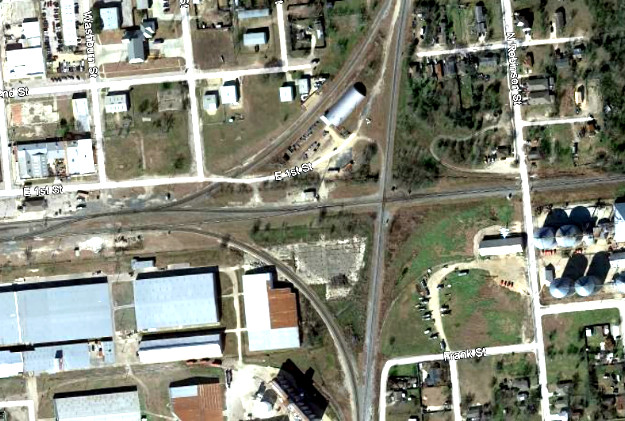
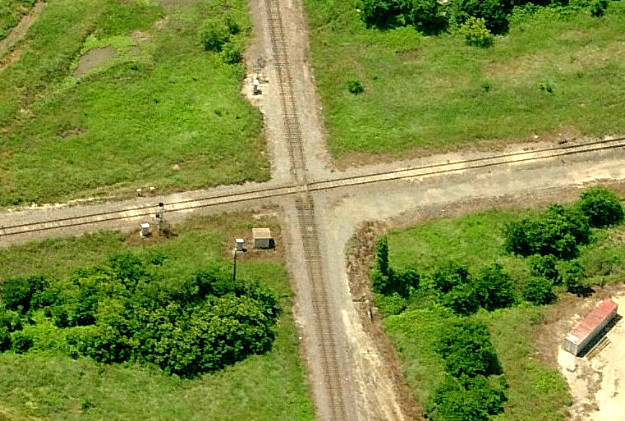
Above Left: This Google Maps 2022 satellite image
of the Tower 34 crossing shows connectors in the northwest and southwest
quadrants. No evidence has been found to indicate that connecting tracks ever
existed in either of the east quadrants. Above
Right: This Microsoft Virtual Earth bird's eye view of the crossing
from c.2008 has south at the top. An interlocker cabinet sits in the northeast
quadrant of the diamond where the tower once stood. The cabinet remains intact,
barely visible on the 2022 imagery, but whether it still houses active
electronics is undetermined.
Below:
R. J. McKay took these two photos of the Taylor passenger depots in 1973 and
1975, respectively.
